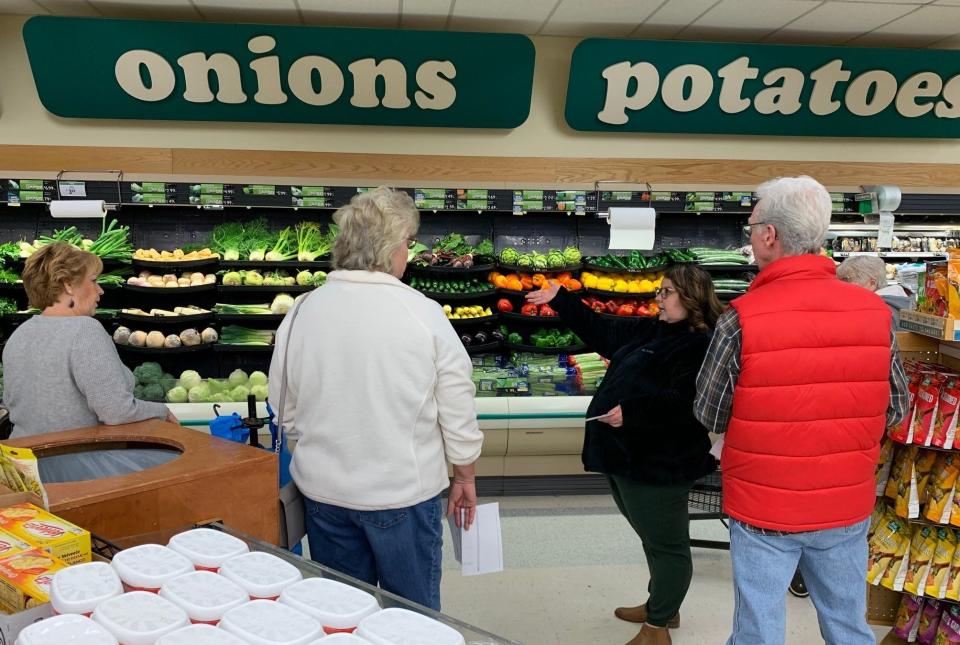Grocery shopping tips for those with diabetes
The Dining with Diabetes reunion class met at Buehler’s last week to walk around the store with LeeAnn Miller, traveling registered dietitian at Coshocton Regional Medical Center. So what does walking around a grocery store have to do with managing diabetes?
Turns out, a lot. During the Dining with Diabetes classes, we focus on nutrition as one important component in a diabetes management plan. Some people are more comfortable cooking at home than others. And navigating the grocery store, with hundreds and even thousands of products on the shelves, can be overwhelming. Here are some tips that our participants walked away with last week.

Plan your meals before you go. It can be easy to fall into a rut of eating the same old things. Having a plan for the meals you will prepare helps you to stay within your desired count for carbohydrates. It also keeps you on track with your budget. If you need some inspiration, check out recipes from extension specific for cooking with diabetes on our website at go.osu.edu/diabetescosh.
Add some variety to your protein sources. When it comes to deli meats, beware of the sodium content. As we walked through the deli section, there was an excellent question about the nutrition of meat sliced at the counter compared to prepacked. Just because it is sliced in front of you does not make it healthier. You can request the nutrition facts for any deli meat to find out calories, fat, sodium and more. Whole cuts of lean meat and poultry and fish, as well as beans and eggs, are good sources of protein.
Pick out different colors of vegetables. The best vegetables to eat are the ones you will eat. Planning out meals will help you reduce the amount of fresh vegetables you waste. Another way to use vegetables before they begin to spoil is to toss small pieces in a freezer bag and keep this frozen to toss into soups or smoothies. Remember that packaged frozen vegetables are full of nutrients and are good to have on hand for cooking.
Stick to the perimeter of the store as much as possible. During our grocery store walk, we did not walk down the aisles. There are certainly foods that are still good to include in a healthy diet, like whole grains and seasonings and canned vegetables. But most of the food products up and down the aisles are convenience foods that can be high in calories, carbohydrate, fat and sodium.
Read the labels. When it comes to eating well with diabetes, the label is your friend. It is the way to know how large a serving should be and how many carbohydrates that food contains. If you have not met with a dietitian to talk about your target for carbohydrate consumption, I highly recommend that you do. A rule of thumb is 30 to 45 grams of carbohydrates per meal for women or 45 to 60 grams carbohydrates per meal for men, depending on the total calories you are aiming to eat each day.
Plan for snacks. Having healthy snacks prepped makes it less tempting to eat the snacks you know are best to avoid. Some great snack ideas include two handfuls of popcorn, a handful of almonds, a handful of grapes with string cheese, a cup of fat-free yogurt or carrot sticks with hummus.
Our next series of Dining with Diabetes classes will be Tuesday evenings in August. Registration will begin in early June.
Today I’ll leave you a quote from Erma Bombeck: "My kids always perceived the bathroom as a place where you wait it out until all the groceries are unloaded from the car."
Emily Marrison is an OSU Extension Family & Consumer Sciences Educator and may be reached at 740-622-2265.
This article originally appeared on Coshocton Tribune: Grocery shopping tips for those with diabetes

